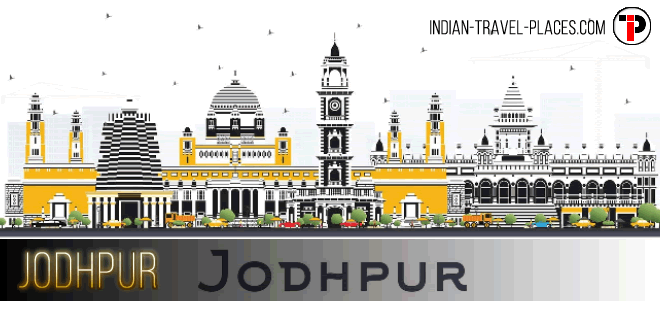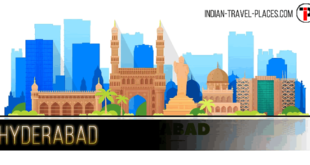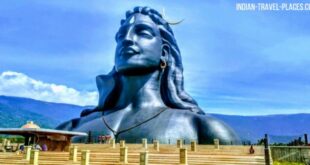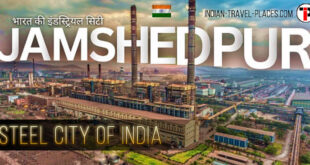Jodhpur is a city in the Thar Desert of the northwest Indian state of Rajasthan. Its 15th-century Mehrangarh Fort is a former palace that’s now a museum, displaying weapons, paintings and elaborate royal palanquins (sedan chairs). Set on on a rocky outcrop, the fort overlooks the walled city, where many buildings are painted the city’s iconic shade of blue.
| Name: | Jodhpur – Blue City of India |
| Location: | Rajasthan State |
| Climate: | Summers: 42° C (Max), 27° C (Min) | Winters: 27° C (Max), 11° C (Min) |
| Best Time to Visit: | October to March |
| Nearest Airport: | Jodhpur Airport |
| Railway Station: | Jodhpur Junction |
| Must Visits: | Umaid Bhawan Palace, Mehrangarh Fort, Jaswant Thada, Mandore Gardens, Balsamand Lake |
| Language Spoken: | Marwari, Hindi, English |
| STD Code: | 0291 |
Jodhpur is a city located in the western of state of India, Rajasthan. This princely city is also known as The Sun City and The Blue City, for the bright and sunny weather it enjoys all year long and the blue painted houses located around the Mehrangarh Fort. Spread over an area of 95 square kilometer, it is the second largest city in the state of Rajasthan and attracts tourists from India and abroad for being a rich cultural heritage site of temples, palaces, and forts set against the backdrop of world’s 9th largest desert, Thar. The city comes alive with the sight of unique handicrafts, folk music, folk dances, and magnificently attired people. The city also boasts of many markets laded with brilliantly handcrafted jewelry, textiles, carpets, marble sculptures, and embroidered shoes known as Mojris. This handicrafts industry makes for exports of up to $200 million and provides indirect employment to close to 200,000 people.
This Sun City was founded in the year 1459 by the Rao Jodha of the Rathore family, who originally belonged to the land of Kannauj, but was driven out from their homeland by the Afghans. Legend has it that they all fled to the land of Pali, near Jodhpur (which was known by the name of Marwar). The Rathore family felt the need to re-establish and gain back their stronghold; which is when Rathore Siahaji married the sister of a local prince. In coming days they had established much support and alliance that they were able to boot out the Pratiharas from Mandore and took over the land but felt the need of a permanent and secure capital. This desire lead to the formation of Jodhpur, named after Rao Jodha. Jodhpur and the Rajputanas continued to flourish under the British Raj and gained a major chunk of percentage in trade throughout India. Post independence the city of Jodhpur merged into the state and became to be known as the second city of Rajasthan.
The tourist attractions of Jodhpur not only include the magnanimously built Forts, palaces and temples, but also include some of the finest markets showcased with superbly made handicrafts that welcome the tourists with genuine heartiness. The Mehrangarh Fort, situated at a height of 150 meters above sea level and spread over an area of 5 sq. km extends to the centre of the city; Umaid Bhawan, a palace made of marble and pink sandstone, parts of which have now been turned into a hotel cum museum; Jaswant Thada, made of white marble in the memory of Maharaja Jaswant II; Mandore gardens, a popular picnic and tourist spot with high rock terraces and beautiful gardens; and Balsamand Lake with a stunning palace located beside the lake make up for a gorgeous collection of tourist attractions. Located 335 kilometers west of the capital city of Jaipur, Jodhpur is well linked through roadways, railways and airways; connecting it to every major of city of India. Make sure to pay this Sun City a visit at least once!
Best Time To Visit Jodhpur
While touring Rajasthan, make a stopover at the ‘Blue City‘ of Jodhpur, the second largest city and most visited tourist destination in Rajasthan. Serving as the sentinel of country’s western border, Jodhpur, with its vibrant history, imposing forts, bustling bazaars and sunlit streets never fails to woo. Split into old and new Jodhpur, a visit to this imperial city is perhaps the best way to get up, close and personal to the multi-faceted grandeur of the place. A trip to any place is incomplete without exploring its tourist attractions, shopping destinations and local fare and the same holds true for Jodhpur as well. From the glorious Mehrangarh Fort to colorful Rajasthani handicrafts to spicy, local Marwari food, Jodhpur has everything to turn you on. To enjoy your trip to the ‘Sun City’ to the max, it is important to plan your travel timings right. Although the city experiences extreme temperature throughout the year, winter and monsoon seasons are far more pleasant time to make a quick trip to Jodhpur. Moreover, the regional festivals held during this time helps you to get close to the cultural side of the city. To know more on the best time to visit Jodhpur, read the article below.
When To Go To Jodhpur
Weather
If you wouldn’t really like to get seared by the desert sun or get blinded by sandstorms, then planning your trip to the ‘Sun City’ keeping the weather conditions in mind would ensure you a hassle free trip. Like rest of Rajasthan, Jodhpur experiences extreme weather conditions, thereby making the place hugely inapt for a summer trip. The summer months of March, April and June are excruciatingly hot and clammy, with mercury levels fluctuating anywhere between 360C min to 420C max. However, if you happen to be in Jodhpur during summer, then make sure to protect yourself from the sun by wearing light cotton clothes and by using sunscreen and sunglasses. The monsoon here, which commences from July to September, brings in light drizzle that gives the city a much-needed respite from the blazing sun. Winters, which begin in December and lasts until February, boasts of moderate atmosphere with temperature ranging between 100C to 240C. Although the day remains sunny, the night brings in the chilly desert breeze.
Best Time To Explore Jodhpur
To escape from the extreme weather conditions of Jodhpur, its best recommended visiting the place any time between October to March. Ideal for sightseeing and travelling, a trip during this time will ensure that you enjoy your trip to the fullest. Apart from experiencing the pleasant climate, you can also be a part of some of the noted celebrations of the region including Dussehra, Diwali and Holi. What is more, the regional festival of the place, the Marwar, celebrated during the month of October/November is a real visual delight and shouldn’t be missed.
Things To Do
On your visit to Jodhpur, take out some time to visit the attractive fort of Mehrangarh. To add some more thrill to your trip, you can visit historical sites of the cities such as Jaswant Thada, Mahamandir Temple and Umaid Bhawan Palace etc. Among the other noted structures of the place, some of the worth visiting are Clock Tower and Sadar Market. Just like the monuments and historical sites, the shopping destinations in Jodhpur are equally noteworthy for their regional attractions like handicrafts, traditional handlooms, blue pots and wooden furniture. Don’t forget to splurge in the colorful shopping lanes of Jodhpur and carry back home some wonderful keepsakes of your memorable trip.
History Of Jodhpur
Erstwhile a part of the Gurjara Pratihara Empire, Jodhpur was ruled by a Baragujar King before it fell into the hands of a Rajput chieftain of the Rathore clique, who established the city of Jodhpur in the year 1459. Rao Jodha, the founder of Jodhpur, was a Rajput ruler who ruled over Marwar before he was defeated in a power struggle. Jodha escaped from Mandore to avoid a fatal destiny and lived in the surrounding areas of Marwar before he went on to capture the neighboring territories. After a period of struggle with the enemies, the place came under the attack of outside intruders like the Mughals. During this time, Jodhpur witnessed more than a few wars, some with its internal rivals and others with the Muslim rule. Later in the 19th century, during East India Company invasion, Pratap Singh came to an agreement with the British Raj and was in good terms with the administers of the East Indian Company before it merged to the state of Rajasthan after Indian Independence. Read the article to know more about the history of Jodhpur.
Jodhpur History
Early Beginnings
A major part of Jodhpur’s history revolves around the rule of Rathore kinfolk. The Rathore originated from the Kannauj tribe from Uttar Pradesh who were forced out by the Ghori tribe. Rathore community traces back their ancestral lineage to the Sun God, which earned it the name of Suryavanshi. The Rathore eventually settled in Mandore before they moved on to Jodhpur and made it their capital. Jodhpur gained its importance only in 1459 when Rao Jodha established his military base in the city by Chintamani Fort that was later renamed as Mehrangarh Fort. By then end of Rao Jodha’s rule, he had captured the nearby region including his birthplace Mandore from where he had escaped from being murdered by Rana Kumbha.
Invasion Of The Mughal Warriors
When a group of Muslim warriors invaded the country in the 1500’s, the Rajput kings united together to drive out the intruders in the battle Panipat. However, they failed miserably and Mughal Empire marked their establishment in India. The Mughal emperor did not find the fruitless land of Jodhpur an attractive prospective that was worth pursuing. Meanwhile Akbar’s father (Humayun) was unseated from his throne in Delhi by Sher Shah Suri who later captured Jodhpur from Raja Maldeo, the then king of the province. After the death of Humayun, his son Akbar captured Jodhpur and Marwar. Maldeo Rathore eldest son was later appointed as the administrator of this region. Relationship between Akbar and Udai Singh improved when his sister Jodha Bai married the Muslim king, which in return forced him to make Udai Singh the future governor of Jodhpur.
Power Struggle
During the peace treaty between Akbar and Udai Singh, Jodhpur not only witnessed a cultural turnabout but also witnessed a thriving trade and commerce activity. The strained relationship took place when Jaswant Singh openly declared his dislike for Shah Jahan’s successor. He was defeated by Aurangzeb and later sent on exile to the Afghan region. In the meantime, Jodhpur underwent sever internal strife for almost three decades before the death of Aurangzeb in 1707. His death marked the decline of the Mughal Empire as his successors were disinterested in the state affairs. Jaswant’s son Ajit Singh was appointed as the king of Jodhpur who brought back the past Rajput glory but it was short lived as he was killed by his own son. The death of Ram Singh, the grandson of Ajit Singh gave rise to the Maratha Dynasty in Rajput terrain.
East Indian Company
Once the Maratha Dynasty had invaded the Rajputana province, Jodhpur saw further struggles for power. During this time, the British who had already entered the sub-continent in 1818, took advantage of this by signing a pact with Pratap Singh, the then descendant of the Man Singh family, to overthrow the Maratha rule. The English brought in peace in Jodhpur and knighted Pratap Singh as the future king of the dessert land. The relationship between the English and Pratap Singh not only strengthened its future but also prospered Indo-Anglo rule with a flourishing trade activities. He also went on to fight under the British rule in many parts of the globe.
Post- Independence
After the death of Pratap Singh, his future heirs only worked toward the development of Jodhpur. By setting a base for Indian aviation, Umaid Singh built India’s first airport that gave rise to the growth of the aeronautic industry in India. Once India got its independence in 1947, Hanwant Singh the ruler of Jodhpur was asked to join Indian politics but declined the request of the Indian National Congress by remaining independent. In 1956, Sardar Vallabhbhai Patel the then Home minister of India merged Jodhpur and other close by princely provinces as a part of Rajasthan state under the State Reorganization Act. Since 1956, the city has always had a member of the Parliament that has represented Jodhpur. Today, however the city is an important constituency for Indian politics.
How To Reach Jodhpur
Jodhpur is the second most populated city in Rajasthan. Once home to the Abhiras and the Aryans, the imperial city of Jodhpur was founded by Rao Jodha, a powerful monarch of the Rathore kinfolk. Also known as the ‘Sun City,’ Jodhpur is strategically located to the west of the state capital, making it an important stop over while touring the state. Besides its many palaces, forts, temples, gardens and the sweltering backdrop of the Thar Desert, the city is feted for being a top-notch handicraft centre. With a thriving business economy in coffee, copper, silk, opium, leather, furniture and date palm, Jodhpur definitely enjoys a coveted status among the entrepreneurs and merchandisers. Some of the most frequented places in Jodhpur are Kalyana Lake, Mehrangarh Fort, Umaid Bhavan Palace, Jaswant Thada, Mandore and Luni Fort. Read the article to know more on how to reach Jodhpur and have a comfortable trip.
Traveling To Jodhpur
By Air
Jodhpur has a domestic airport, which is located 5 km away from the middle of the city, in the cantonment area and is administered by the Indian Air Force. This domestic airstrip connects you to other major cities of Delhi, Mumbai, Kolkata, Chennai, Bangalore, Udaipur, Jaipur, Hyderabad, Ahmedabad and more. The airlines operating from Jodhpur are Air India, IndiGo, Go Air, Air India-IC, Go Business, Jet Airways Konnect, Jet Airways, Kingfisher Red, JetLite, Kingfisher and SpiceJet. The nearest international airport to Jodhpur is the Indira Gandhi International Airport in Delhi, which is about 600 km away from the city.
By Rail
If the prospect of traveling by air seems a little too heavy on your pocket, then you can always resort to the next best option, the railways. The trains connect Jodhpur to different Indian cities of Delhi, Mumbai, Kolkata, Ahmedabad, Jaipur, Bangalore and Hyderabad. The Rajasthan tourism board has taken an active initiative to boost the tourism industry by starting a lavish train, popularly known as ‘The Palace on Wheels’. This extravagant coach ride not only lets you bask in the beauty of Jodhpur’s topography but also promises a complete royal treat to every passenger on board. Whether you are looking for a simpler or a luxury means to travel across the state, the railways in Rajasthan has something for everyone.
By Road
The roadways in Rajasthan are equally developed as compared to its other transport options. The Rajasthan State Road Transport Corporation runs several luxury air-conditioned buses that travel back and forth to Jodhpur frequently. Besides this, several tour operators provide chauffeured cab services that would take you anywhere in the city. No matter in which part of the country you are, you won’t ever have any difficulty in reaching the city by road as the city is well connected to Delhi, Jaipur, Ajmer and Pali.
Local Transportation
If you are looking for a comfortable mode of transportation to travel around the city, then tourist cabs are definitely your pick. The taxis charge you on an hourly basis and are the best way to ply short distances. Apart from that, there are mini buses that would take you anywhere in the city for a very minimal fare. However, if budget is not a constraint, then hiring cars will give you the freedom to drive down the narrow lanes of Jodhpur and explore the city, as you like. One can also go for unmetered auto rickshaws and horse driven carriages to explore the place.
Places To Visit In Jodhpur
There is something magical about Jodhpur and you realize this the moment you set your eyes on the palatial beauty of its architecture and wade through its sun-kissed alleyways. Perched atop a rocky cliff, the city of Jodhpur serves as an oasis of beauty amidst the vast sandy desert. Fondly dubbed as the ‘Sun City,’ the imperial of Jodhpur, with its rich culture, splendor and historical legacy definitely serves as a testimony of Rajasthan’s glorious historical past. The palatial palaces, rambling forts, majestic temples and other monuments offer a sneak-peek into the exotic spectrum of the city’s heritage. Added to this are the irresistible shopping attractions of this place, which is nothing short of a visual treat. However, the joys of Jodhpur aren’t just restricted to sightseeing and shopping alone. Come here, dunk your jaws in princely feast, and savor the authentic Marwari cuisine. Go ahead and explore the article to know more about tourist attractions in Jodhpur.
Tourist Attractions In Jodhpur
Mehrangarh Fort
Mehrangarh Fort, located in heart of the city, is one of the finest and most attractive forts in India. The glorious fort, situated on a hillock at a height of 125 m, gives a birds view of the entire city. Spread over an area of 5 km, the fort has seven beautiful gates to welcome its visitors. Huge number of tourists visits this place every year to have a glimpse of Rajput glory. Along with the vast collections of artillery system, the fort is home to some of the spectacular palaces like Phool Mahal, Moti Mahal and Sheesh Mahal. As you keep wandering in the fort area, don’t forget to explore the stunning museum, which boasts of a wide collection of books, literature and some of the unique and best handicrafts.
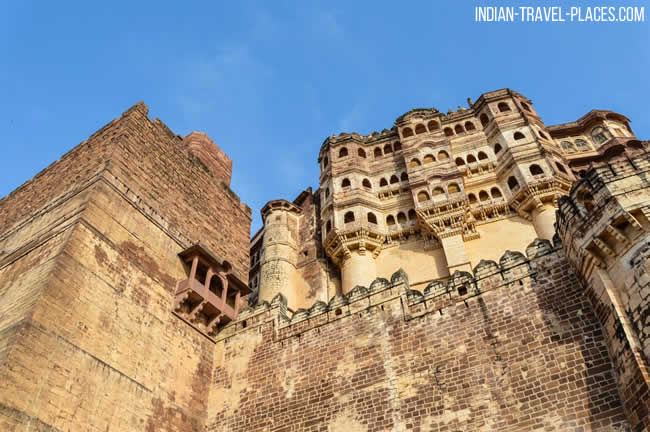
Umaid Bhawan Palace
Umaid Bhawan Palace, another interesting landmark of Jodhpur, is situated at the top of Chittar Hill and allures tourists by its stunning beauty and amazing architecture. A 20th century monument, the palace was built by Maharaja Umaid Singh in order to provide employment to nearly 3000 famine hit people of Rajasthan. Built between 1923 and 1940, the palace is highly praised for its rose sandstone and marble structure, which adds a romantic appeal to this lavishly carved palace of Jodhpur. Popularly known as Chittar Mahal by locals, presently the palace serves as the residence to former rulers, while a part of it stands tall as a heritage hotel and the remaining part of it has been converted into a museum where you can enjoy the wonderful display of royal swords, war costumes, miniature paintings and noted antiques.
Jaswant Thada
Jaswant Thada, located near Mehrangarh Fort, acts as a spectacular example of Rajput glory. The monument, built in 1899 in the memory of famous Rajput ruler Jaswant Singh II, serves as the shrine of the king. As per the legends, Maharaj Jaswant Singh succumbed to injuries in this place during the fight with the great Mughal king Jahangir. The white marble beauty of the cenotaph has the power to captivate your attention with intricate latticework, elaborate carvings, mesmerizing gardens and brilliant portraits of great Jodhpur rulers. A separate section dedicated to the brave queens of Jaswant Singh who committed sati on death of king adds grandeur to the monument with the beautiful sculptures and ornamented pillars. With all the captured beauty in its womb, Jaswant Thada is the must visit place on your trip to Jodhpur.
Mahamandir Temple
Situated at Mandore Road, the Mahamandir temple is an architectural gem. Constructed in the year 1812, the magnificent temple is renowned for its carvings on stones, sculptures and elaborate pillars ornamented with attractive yogic postures. As you enter the temple, the serenity of the surroundings makes you lose yourself to the divine blessing of Lord Shiva situated in the shrine.
Rai Ka Bag Palace
Rai Ka Bag Palace, situated near city’s railway station, was constructed in 1663 by Hadiji, the queen of King Jaswant Singh I. It was one of the favorite places of Jaswant Singh II, where he has spent most of his life. Later in 1883, during the visit of Swami Dayanand Saraswati, arrangements were made in this palace for his public audience who came to listen his divine speech.
Government Museum
Among the list of appealing tourist attractions of Jodhpur, the government museum is the most attractive landmark, which seeks attention of every tourist of the city. Situated in Umaid public garden in High Court Road, the museum was built during the reign of Maharaja Umed Singhji. The beautiful architecture of the museum houses wide collection of weapons, royal clothes, handicrafts, miniature portraits and sculptures. Along with innovative collected works, there is a public library and zoo in the lush green Umaid gardens. If you like to explore the major attractions of museum then you can pay a visit on any day expect Friday and national holidays from 10 am to 5 pm.
Shopping In Jodhpur
If you thought that Jodhpur was all about peerless architecture and imperial ruins, wait until you step into one of those bustling shopping lanes of the city and get completely bowled over by its endless array of colors, textiles, trinkets and more. Shopping in Jodhpur is one-of-its-kind of an experience. From old bazaars to rural hubs to the major commercialized areas, touring down the busy shopping lanes of Jodhpur is an inimitable experience. While shopping in Jodhpur, don’t forget to stuff your bags with goodies like fine Rajasthani tie-and-dye, mirror-work and block printed textiles, traditional paintings, blue pottery, light-weight quilts, carpets and more. Apart from this Jodhpur is quite famous for its wooden craft, traditional dolls, handmade lamps, colorful bangles etc. Today, Jodhpur has emerged as an important export centre, making Jodhpur an internationally sought after shopping destination in India. Navigate through the article to know more about the shopping places in Jodhpur.
Things To Buy In Jodhpur
Antique
If you are an antique lover or a collector, then your hunt for old Indian pieces ends here. Umaid Bhavan has several shops that sell an incredible variety of different goods such as pottery, silver ware, textile, carved ducks, sculptures, metal objects, paintings, ivory, furniture, rare first edition books, wooden carvings etc. If you don’t have the budget to buy an original antique piece, then you can always purchase a replica that is not only cheap but also make for a great gift to carry back home. Rajasthan Art Emporium, Rajasthan Arts and Crafts House and Sun City Art Exporters are the best place to look out for antiques.
Textiles
Jodhpur also has a huge textile industry that sells tie-and-dye, mirror-work and block print fabrics. These tie-and-dyed materials have beautiful traditional motifs that are sold in a variety of cloth such as cotton, silk, and chiffon. From colorful saris to ethnic dress and bright turbans, Rajasthan has a wide range of collection that will entice any shopper. The best place to purchase Indian traditional ware is form Kapraa Bazaar, Sojati Gate Market, Nai Sarak Market and Sadar Market.
Leather
Another thing to look out for while shopping in this city is for its leather products. The footwear in Jodhpur is simple fascinating as there is a wide collection of Indian footwear that is worn with Indian clothes such as sari, salwar kameez, sherwani and Jodhpuri suits. Most of this footwear comes in different patterns, colors and designs with beautiful sequins work. The price of these leather goods are relatively cheaper and can be easily found on the streets of Mochi Bazaar and Jutti Corner on Station Road. You cannot leave Jodhpur without buying this footwear.
Accessories
If you are looking to take back a few delicate sliver trinkets for close friends and family, then you can be sure to find more than a few shops in the marketplace of Jodhpur. Take a stroll through Sarafa Bazaar to find ethnic silver jewelry, colorful lac bangles to match your outfit and well designed photo frames. Sarafa Bazaar is a great place to do some street shopping.
Carpets
It is a well known fact that Jodhpur has a thriving handicraft industry. The carpets in Jodhpur are a treat to your eyes. Visit High Court Road to find some unique colorful rugs and durries. Most of these carpets are hand weaved that displays traditional designs with a burst of color. You can also find a few wall hangings with beautiful embroidery work that promise to brighten your decor.
Spices
Jodhpur is popular for its red chilies that are exported to many parts of the world. Mathaniya’s red chili is known for its rich dark red color that will set your palates on fire. The best place to shop for spices in Jodhpur is in Clock Tower for an intriguing and unusual experience.
Other Bazaars
If you do have a few more hours to spend in the city before you leave Jodhpur, then make a quick jaunt to Tripolia Bazar for handicrafts products and textiles items, Lakhera Bazaar for Lac work bangles and Sardar Market to complete your shopping excursion in the city.
 ITP Indian Travel Places: Food, Travel, Tourism Business Events and Trade Shows
ITP Indian Travel Places: Food, Travel, Tourism Business Events and Trade Shows
